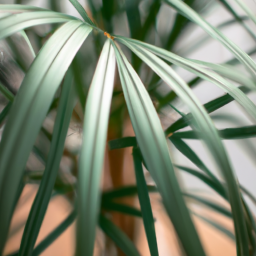
Are you looking to bring a touch of the tropics into your home? Indoor palm trees are a great way to add a bit of greenery and a relaxed vibe to any space. In this blog post, we will explore the various types of indoor palm trees that are perfect for adding a touch of nature to your indoor environment. Whether you are a seasoned plant parent or just starting out, there is a perfect indoor palm tree for everyone. So, let’s dive in and discover the beauty and diversity of types of indoor palm trees!
Areca Palm: A Popular Choice for Indoor Greenery
Welcome to our guide on the different types of indoor palm trees! If you’re looking to add a touch of tropical flair to your home or office, palm trees are a fantastic choice. In this article, we’ll be focusing on the Areca Palm, a popular choice for indoor greenery. Let’s dive in and learn more about this beautiful plant!
Overview of the Areca Palm
The Areca Palm, also known as Dypsis lutescens or Butterfly Palm, is a stunning palm tree that is native to Madagascar. It is one of the most popular choices for indoor greenery due to its elegant appearance and low maintenance requirements. The Areca Palm features feathery, arching fronds that can reach up to 7 feet in length, creating a lush and tropical atmosphere in any space.
When it comes to caring for an Areca Palm indoors, it is important to provide it with bright, indirect sunlight and well-draining soil. This plant thrives in humid environments, so misting the leaves regularly or placing a humidifier nearby can help keep it happy and healthy. Watering should be done when the top inch of soil feels dry to the touch, and fertilizing every 2-3 months during the growing season can help promote growth and vibrancy.
One of the key benefits of having an Areca Palm indoors is its air-purifying properties. This plant is known for its ability to remove toxins such as formaldehyde, benzene, and trichloroethylene from the air, making it a great choice for improving indoor air quality. In addition to its health benefits, the Areca Palm also adds a touch of natural beauty and tranquility to any space.
Tips for Growing and Caring for an Areca Palm
When it comes to growing and caring for an Areca Palm, there are a few key tips to keep in mind. First and foremost, make sure to place your palm tree in a location that receives bright, indirect sunlight. Direct sunlight can scorch the leaves, while too little light can cause the plant to become leggy and sparse.
In terms of watering, it’s important to keep the soil consistently moist but not waterlogged. Allow the top inch of soil to dry out slightly between waterings, and be sure to use a well-draining potting mix to prevent root rot. During the growing season, fertilize your Areca Palm every 2-3 months with a balanced liquid fertilizer to promote healthy growth.
Another important aspect of caring for an Areca Palm is maintaining a humid environment. This plant thrives in high humidity, so misting the leaves regularly or placing a tray of water nearby can help keep it happy and healthy. If the air in your home is particularly dry, consider investing in a humidifier to create the ideal growing conditions for your palm tree.
Common Issues and Troubleshooting
While the Areca Palm is relatively low maintenance, there are a few common issues that you may encounter when caring for this plant. One of the most common problems is yellowing or browning leaves, which can be caused by overwatering, underwatering, or exposure to direct sunlight. To remedy this issue, adjust your watering schedule and move the plant to a more suitable location.
Another issue that you may face with an Areca Palm is pest infestations, such as spider mites or mealybugs. To prevent and treat pests, regularly inspect the plant for signs of infestation and use insecticidal soap or neem oil to control the problem. Additionally, regularly wiping down the leaves with a damp cloth can help keep pests at bay and promote overall plant health.
In conclusion, the Areca Palm is a beautiful and popular choice for indoor greenery due to its elegant appearance, air-purifying properties, and low maintenance requirements. By following the tips and guidelines outlined in this article, you can successfully grow and care for an Areca Palm in your home or office. Bring a touch of the tropics into your space with this stunning palm tree!

Types of Indoor Palm Trees
Welcome to our guide on the different types of indoor palm trees! If you’re looking to bring a touch of tropical beauty into your home or office space, palm trees are a fantastic choice. Not only do they add a lush and vibrant feel to any room, but they also help purify the air and create a calming atmosphere. In this article, we’ll explore some of the most popular indoor palm tree varieties and how to care for them.
1. Majesty Palm
The Majesty Palm, also known as Ravenea rivularis, is a stunning addition to any indoor space. With its graceful fronds and tall, slender trunk, this palm tree adds a touch of elegance and sophistication to your home or office. Majesty Palms are native to Madagascar and are known for their lush green foliage and tropical appearance.
When caring for a Majesty Palm, it’s important to place it in a bright, indirect light location to ensure it thrives. Water your Majesty Palm regularly, keeping the soil consistently moist but not waterlogged. You can also mist the leaves occasionally to increase humidity and prevent browning.
With proper care, your Majesty Palm can grow up to 10 feet tall indoors, making it a striking focal point in any room. Remember to fertilize your palm tree every few months during the growing season to encourage healthy growth and vibrant foliage.
2. Areca Palm
The Areca Palm, also known as Dypsis lutescens, is another popular choice for indoor spaces due to its feathery fronds and graceful appearance. This palm tree is native to Madagascar and is prized for its ability to purify the air and create a tropical ambiance.
To care for an Areca Palm, place it in a location with bright, indirect light to prevent scorching of the leaves. Water your palm tree regularly, allowing the soil to dry out slightly between waterings. You can also mist the leaves occasionally to increase humidity and prevent spider mites.
With its fast growth rate, the Areca Palm can quickly fill a corner or empty space in your home with its lush foliage. Regularly prune dead or yellowing fronds to keep your palm tree looking its best and encourage new growth. Fertilize your Areca Palm every few months during the growing season to promote healthy foliage and vibrant green color.

Parlor Palm: A Low-Maintenance Option for Indoor Plant Enthusiasts
Introduction
When it comes to adding a touch of greenery to your indoor space, palm trees are a popular choice among plant enthusiasts. One of the most beloved varieties is the Parlor Palm, known for its elegant fronds and low-maintenance nature. In this guide, we will delve into the world of indoor palm trees, with a focus on the Parlor Palm and why it is a great option for those looking to bring a bit of the tropics into their home.
Why Choose the Parlor Palm?
The Parlor Palm, also known as Chamaedorea elegans, is a versatile and easy-to-care-for plant that thrives in indoor environments. Its compact size makes it perfect for smaller spaces, and its graceful fronds add a touch of elegance to any room. This palm variety is native to the rainforests of Southern Mexico and Guatemala, where it grows under the canopy of larger trees. This means that the Parlor Palm is well-suited to low-light conditions, making it an ideal choice for indoor spaces with limited natural light.
One of the main reasons why the Parlor Palm is a popular choice among indoor plant enthusiasts is its low-maintenance nature. This palm variety is relatively easy to care for, requiring minimal attention to thrive. It is tolerant of a wide range of indoor temperatures, making it a great option for those who may not have a green thumb. The Parlor Palm is also a slow-growing plant, meaning that it will not outgrow its space quickly and will require less frequent repotting compared to other palm varieties.
In addition to being low-maintenance, the Parlor Palm is also known for its air-purifying qualities. Like all plants, the Parlor Palm absorbs carbon dioxide and releases oxygen during photosynthesis. This helps to improve the air quality in your home, making it a healthy choice for indoor spaces. The Parlor Palm is also non-toxic to pets, making it a safe option for households with furry friends.
Caring for Your Parlor Palm
When it comes to caring for your Parlor Palm, there are a few key things to keep in mind to ensure that it thrives in your indoor space. First and foremost, it is important to place your palm in a spot where it will receive indirect sunlight. While the Parlor Palm can tolerate low-light conditions, it will still benefit from some exposure to natural light. Avoid placing your palm in direct sunlight, as this can cause its delicate fronds to burn.
In terms of watering, the Parlor Palm prefers consistently moist soil, but it is important not to overwater. Allow the top inch of soil to dry out between waterings, and be sure to use a well-draining potting mix to prevent waterlogged roots. During the growing season, from spring to fall, you may need to water your palm more frequently, but be sure to adjust your watering schedule during the winter months when growth slows down.
In terms of humidity, the Parlor Palm prefers higher levels of humidity, making it a great choice for bathrooms or kitchens. You can increase humidity levels by misting your palm with water, placing a humidifier nearby, or grouping it with other plants. Finally, be sure to fertilize your Parlor Palm every 2-3 months during the growing season with a balanced liquid fertilizer to promote healthy growth.
In conclusion, the Parlor Palm is a fantastic option for indoor plant enthusiasts looking to add a touch of greenery to their home. With its elegant fronds, low-maintenance nature, and air-purifying qualities, this palm variety is sure to thrive in your indoor space with minimal effort on your part. By following the care tips outlined in this guide, you can enjoy the beauty of the Parlor Palm for years to come.
Crisp Recap
If you’re looking to add a touch of tropical paradise to your indoor space, consider incorporating indoor palm trees into your decor. There are a variety of different types of indoor palm trees to choose from, each with its own unique characteristics and care requirements. From the popular Areca palm with its feathery fronds to the elegant Kentia palm with its slender, arching leaves, there’s a palm tree to suit every taste and space.
Some indoor palm trees, like the Parlor palm, are well-suited to low light conditions, making them perfect for adding a touch of greenery to dimly lit corners. Others, like the Majesty palm, thrive in bright, indirect light and can add a bold statement to any room. No matter which type of indoor palm tree you choose, be sure to research its specific care needs to ensure it thrives in its new home. With a little bit of attention and the right conditions, your indoor palm tree can bring a little slice of the tropics into your everyday life.
Q&A Corner:
Q1: What are some common types of indoor palm trees?
A1: Some common types of indoor palm trees include the Areca Palm, Parlor Palm, Kentia Palm, Majesty Palm, and Lady Palm. Each type has its own unique characteristics and care requirements.
Q2: Which indoor palm trees are best for low light conditions?
A2: If you have low light conditions in your home, consider getting a Parlor Palm or a Kentia Palm. These types of indoor palm trees are more tolerant of lower light levels compared to other varieties.
Q3: How often should indoor palm trees be watered?
A3: Indoor palm trees should be watered when the top inch of soil feels dry to the touch. Depending on the type of palm tree and the environmental conditions, this could range from once a week to once every two weeks.
Q4: What are some tips for caring for indoor palm trees?
A4: Some tips for caring for indoor palm trees include providing them with enough light, keeping them away from drafts, maintaining proper humidity levels, and using well-draining soil. Regularly dusting the leaves and checking for pests is also important.
Q5: Can indoor palm trees be placed outdoors during the warmer months?
A5: Yes, indoor palm trees can be placed outdoors during the warmer months as long as they are gradually acclimated to the outdoor conditions. Make sure to bring them back indoors before the temperatures drop in the fall.
Dr. Olivia Green is a botanist with over two decades of experience in indoor plant cultivation. She holds a Ph.D. in Plant Biology and has dedicated her career to researching plant behavior in controlled environments. Dr. Green is passionate about helping plant enthusiasts master the art of indoor gardening through her extensive knowledge and practical insights.


